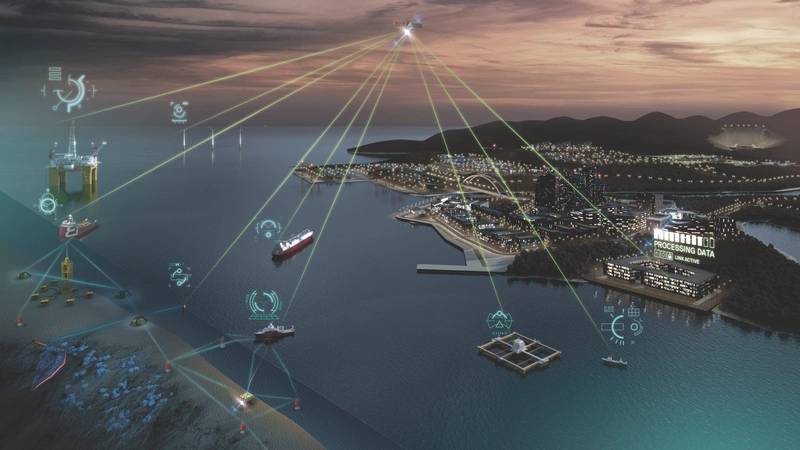
How cloud-based computing is transforming subsea survey
Digitalization has revolutionized the world, and hydrographic survey techniques are no exception. While advances in mechanical design have enabled the survey of increasingly remote locations, electronics and digital processing techniques have dramatically increased resolution. Where once a few spot soundings were considered enough to make a chart, today’s survey vessels generate vast amounts of data to give unprecedented detail.
Detail is good, but data in these quantities needs careful management if it is not to become overwhelming. Modern sounders, such as Kongsberg’s EM range, can produce data at a rate of more than 1 gigabyte (GB) per minute – too much to economically transmit ashore in real time, and impractical to store locally in raw form. Fortunately, real-time processing can greatly reduce the burden for transmission or storage.
Although most surveys are carefully planned, it’s of great benefit to be able to analyze the data while the equipment is at sea, enabling unusual results to be verified and survey gaps to be revisited. Called Mapping Cloud, it is underpinned by Kognifai, which is Kongsberg Digital’s solution for an open, cloud-based environment.
Collaboration via the cloud
The purpose of Kognifai, which is based on Microsoft’s Azure cloud computing platform, is to support collaboration and knowledge-sharing between and within organizations, and to assist academia and the public in developing a broader understanding of the world around us. A good example of how Kognifai and Mapping Cloud are already facilitating this is the Frisk Oslofjord project.
Kognifai is an open, standard platform, designed to make it easy for developers to create applications. In addition, Kongsberg Digital offer several software development kits (SDK) to assist in application development. These contain edge connectors, 3D tools, application framework support, authentication and authorization systems, dashboard widgets, database solutions, routing and queue support features.
As an open platform, the range of applications supported by Kognifai is diverse. Recent organizations to join Kognifai include the UK Met Office, Finnish maritime communications technology developer KNL Networks and cyber-security experts KPMG
The scope for data generation and, more importantly, sharing and collaboration on such a platform is immense. Kongsberg currently has a footprint on more than 30,000 ships; as an example, the company’s Division for Vessel and Fleet Performance has more than 1,000 ships from Europe, Asia and the US using Kognifai, making it possible for ship owners to monitor the status of their assets from any web browser in any location.
The cloud also offers almost infinite capacity for storage. Kognifai allows large data sets to be stored, which remain exclusive to the user unless they grant access to others. This can be done on an individual or group basis and on a permanent or time-limited basis. If they are prepared to grant more general access, large datasets facilitate machine learning, allowing Kognifai to generate additional future value for its users.

Making the most of storage
Mapping Cloud is a joint concept developed by Kongsberg Digital and Kongsberg Maritime’s Subsea business. Capable of accepting input from a range of different sources including cameras, multibeam echosounders and temperature sensors, it is built on Kognifai and targets the survey industry. The first application to be released within Mapping Cloud is Storage, designed with an interface similar to other PC-based file managers to make it intuitive to use. However, there are a few differences which tailor its functionality for the data-intense, collaborative world of modern hydrography.
The ability to automatically gather and aggregate data from diverse sources in a single, globally accessible location facilitates efficiency in survey applications.
Taking a remote view
Advanced sonar systems, such as Kongsberg’s EM sounders, can perform significant real-time processing, thus limiting the amount of data it is necessary to store or transmit. The amount and type of processing carried out is configurable, and Mapping Cloud facilitates doing so remotely.
This allows the operator to ensure that only necessary data is uploaded to Mapping Cloud Storage, and to tailor the system to the available communication bandwidth. This becomes valuable when unmanned surface vessels (USV) are used. A single mother ship can have control of a fleet of these craft, which allows large areas to be surveyed by a small team, in areas which might otherwise be inaccessible. USVs are often also used in support of autonomous underwater vehicles (AUVs), with the potential to extend survey depths to 6,000 meters.
A local wireless system may be used to transfer data between vessels in the fleet. It can then be processed further on the mother ship before upload to Mapping Cloud via a shore link, which is likely to be higher bandwidth and less expensive than satcom.
Once the data is in the cloud, the end user for the survey can monitor the progress and quality of the survey, allowing for immediate feedback.



